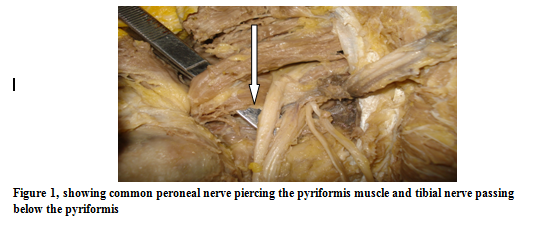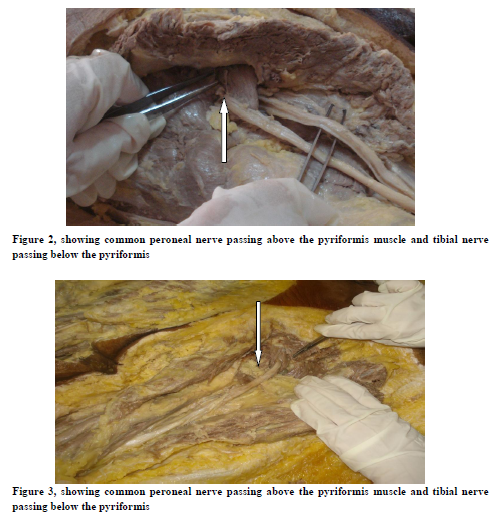IJCRR - 5(21), November, 2013
Pages: 56-60
Date of Publication: 21-Nov-2013
Print Article
Download XML Download PDF
A CADAVERIC STUDY ON ANATOMICAL VARIATIONS OF SCIATIC NERVE IN RELATION TO PYRIFORMIS MUSCLE IN ANDHRA PRADESH REGION
Author: Prathiba K., Seema Madan, Udaya Kumar P., Dharmendar P., Nisha
Category: Healthcare
Abstract:Introduction: The sciatic nerve is the largest nerve of the body. Not only does it have the largest number of nerve fibers, but it also supplies a vast region. Compression of sciatic nerve any where during its course may contribute to clinical conditions like sciatica and pyriformis syndrome. Anomalous sciatic nerve and its branches can often be damaged by wrongly placed intra-muscular injections and during pelvic and total hip replacement surgeries. The present study was conducted to highlight different variations in course and branching pattern of the sciatic nerve in Andhra Pradesh population. Materials and Methods: The present study was carried out on gluteal regions of 100 lower extremities of 50 embalmed cadavers during routine dissection practices for undergraduates in the dissection hall of Gandhi medical college and Osmania medical colleges of Andhra Pradesh, India. Results and Conclusion: In the present study 92 out of 100 specimens sciatic nerve passed below pyriformis into gluteal region then descended downwards in the back of thigh, which terminated in to common peroneal nerve and tibial nerve in the popliteal fossa as usual. In 3% cases common peroneal nerve pierced pyriformis and tibial nerve passed below the muscle. Common peroneal nerveand tibial nerve passed above and below the pyriformis respectively in 4% cases. Unsplit sciatic nerve piercing the piriformis is found in 1 case only.
Keywords: Sciatic nerve, Tibial nerve, Common peroneal nerve, Pyriformis, Pyriformis syndrome
Full Text:
INTRODUCTION
The sciatic nerve is the largest nerve of the body. Not only does it have the largest number of nerve fibers, but it also supplies a vast region. It is the continuation of the upper band of the sacral plexus. It is formed by ventral rami of L4, L5, S1, S2, and S3. It passes out of the pelvis through the greater sciatic foramen below the piriformis. Then it descends between the greater trochanter of the femur and the tuberosity of ischium and along the back of the thigh. It divides in the lower 1/3rd of the thigh into two large terminal branches named tibial and common peroneal nerves.
Compression of sciatic nerve any where during its course may contribute to clinical conditions like sciatica and piriformis syndrome. Anamolous sciatic nerve and its branches can often be damaged by wrongly placed intra-muscular injections and during pelvic and total hip replacement surgeries.
The present study was conducted to highlight different variations in course and branching
pattern of the sciatic nerve in Andhra Pradesh population. A knowledge of the variations of the sciatic nerve could help Anesthetists, Neurosurgeons and Orthopaedicians to avoid surgical errors.
MATERIALS AND METHODS
The present study was done on gluteal regions of 100 lower extremities of 50 embalmed cadavers during routine dissection practices for undergraduates in the dissection hall of Gandhi medical college and Osmania medical colleges of Andhra Pradesh, India. Skin incision was given, gluteus maximus muscle was identified, incised and reflected as per the instructions in Cunningham’s manual of practical anatomy 15th edition. Sciatic nerve was identified and its relation to the pyriformis muscle was noted. The sciatic nerve was then traced down till its division into common peroneal and tibial branches. All the observations were meticulously tabulated and compared with previous studies
OBSERVATIONS
In the present study 92 out of 100 specimens showed normal pattern of sciatic nerve. i.e. sciatic nerve passed below pyriformis into gluteal region then descended downwards in the back of thigh, which terminated into common peroneal nerve and tibial nerve in the popliteal fossa. The variationsvof the nerve in relation to pyriformis are shown in the table no 1.
DISCUSSION
The sciatic nerve is the largest nerve arising from lumbosacral plexus. It innervates 28 muscles of the lower limb. Normally it leaves the pelvis through the greater sciatic foramen and runs below the pyriformis to enter the gluteal region. Variations in its relationship with the piriformis have been observed by several workers. Entrapment of the nerve within the piriformis muscle is one of the reasons of its compression, the condition being called ‘pyriformis syndrome’. A large number of cases of sciatic nerve injuries have been recorded due to intra-muscular injections been given in the gluteal region. The chances of damaging the sciatic nerve in children are higher, more so in neonates and malnourshied infants. Therefore the possibility of variations of its course should be consider seriously, which otherwise would lead to unwanted consequences.
Initial studies on the sciatic nerve and its variations started late back in nineteenth century. Several authors reported that the sciatic nerve divides in the pelvic region itself, even before it enters the gluteal region. Beaton L E, et al2 in 2250 lower limbs and Lee c. s. et al6 in 168 lower limbs observed that the common peroneal nerve, as it enters the gluteal region, pierced the piriformis muscle in 11.7% and 19.6% respectively while tibial nerve passed below the muscle. Chiba S3 dissected 514 lower extremities and observed that in 34% of cases common peroneal nerve pierced through the piriformis muscle. Gabrielli, et al5, Ewa Okrazeweska, et el4, Anne M R Agur, et al1, Ronald A Bergman et al12, Pokorny D, et al11, Vincenti EJD, et al14 and Mustafa Guvencer, et al10 observed the same in 11.2%, 2%, 12.2%, 12 %, 14.3%, 15% and 16% of cases respectively. Machado, F.A., et al8, performed the same study on 100 foetuses and showed that in 16% of cases, common peroneal nerve pierced the pyriformis muscle.
In the present study of 100 lower limbs, 3% were seen to have this type of variation.
Beaton L E, et al2, Gabrielli, et al5, Ewa Okraszweska, et al4, Machado, et al8, Pokorny D, et al11, Mustafa Guvencer, et al10 in their individual studies, observed that the common peroneal nerve passed above the pyriformis and the tibial nerve below the pyriformis after dividing in the pelvis, in 3.3% 2.5% 5.5% 2% 4.4% 8% in of cases respectively.
During the present work the common peroneal nerve and tibial nerve were found to pass above and below the piriformis muscle respectively in 4% of limbs.
There were studies which reported a rare type of variation, that the sciatic nerve enters the gluteal region unsplit and piercing through the pyriformis muscle.
Beaton L E, et al2 observed that in 0.8% of cases entire sciatic nerve pierced the piriformis muscle. Ewa okraszweska, et al4, Pokorny D, et al11, Ronald A. Bergman, et al12, observed the same in 8.3%, 2.2% and 2.25% cases respectively. The present worker found this type of variation in 1 case only.
M. A. Babinski, et al7 reported a rare variation of the high division of the sciatic nerve surrounding superior gamellus muscle In the common peroneal nerve passed between piriformis and the superior gamellus muscle and the tibial nerve passed below the superior gamellus muscle. Another case of high division of sciatic nerve was observed by Md Hassan Ali et al7 in which the right side sciatic nerve divided just 1cm below the piriformis muscle and on the left side division of sciatic nerve was seen 2cm below the piriformis. However on both sides the sciatic nerve divided above the superior gamellus muscle. Sateesha Naik, et al observed trifurcation of sciatic nerve in the middle of popliteal fossa. No such variations were observed in the present study.
SUMMARY AND CONCLUSION
It has been observed during clinical practice that the commonest causes of sciatic nerve injuries could be either intra muscular injections given in the gluteal region or the posterior dislocation of the hip joint. Such injuries are more common in malnourished infants and neonates due to lack of subcutaneous tissue and less muscle mass. When unsplit nerve or any of its division passes through the piriformis, a painful condition resembling sciatica called piriformis syndrome can occur. Compression of nerve fibers during the maximum contraction of pyriformis muscle could be the cause of pain. So the knowledge of the variations of sciatic nerve will help Anesthetists, Neurosurgeons and Orthopedic surgeons to avoid surgical errors.
Author wishes to continue the study in a larger group of individuals by adopting advanced radiological methods to detect variations in the sciatic nerve.
Competing Interests
The authors declare that we have no competing interests
Ethical committee clearance
As the study included only human cadavers, ethical committee clearance was not taken into consideration. Authors will take the responsibility of any further allegations regarding ethical clearance that arise from the study.
ACKNOWLEDGEMENTS
I thank Dr. Ashok Kumar, Professor of Dept of Anatomy and my colleagues for their precious suggestions and support during the study. I extend my gratitude to all the scholars / authors / editors / publishers whose articles, journals are reviewed, cited and included in the references of this manuscript.



References:
- Anne M. R. Agur, Arthur F. Dally; Relationship of sciatic nerve to piriformis. Grant’s atlas of anatomy, 11th edition, page-372, 5.26B, lippincott Williams and wilkins, 2005.
- Beaton L.E, Anson B.J; The relation of sciatic nerve and its sub divisions to the piriformis muscle.Anat. Rec. 70:1-5, 1937 (cited by W. Henry Hollinshed, Anotomy For Surgeons; Volume 3, 2nd edition, page-687, 1958, Paul B. Hoeber inclu.)
- Chiba S; multiple positional relationships of nerves arising from sacral plexus to the piriformis muscle in humans. Acta Anat. Nipon 67: 691-724. 1992.
- Ewa Okraszewska, tukasz Migdalski, kazimierz S. Jedrzejewski, Wojciech
- Bolanowski; Sciatic nerve variations in some studies on the polish population and its stastical significance. Folia Morphol. Vol. 61, No. 4, pp. 277-282, 2002.
- Gabrielli, Carla, Olave, Enrique, Mandiola, Eduardo et al. Inferior gluteal nerve cource associated to the high division of the sciatic nerve. Rev. chil. Anat., 1997, Vol.15, no.1, p. 79-83.
- Lee C S, T Sai T L; The relation of the sciatic nerve to the piriformis muscle. J. Formasan Med. Assoc. 73: 75-80, 1974. (Cited by Zeliha Kurtoglu, M. Haluk Ulutuku; A combined variation in the gluteal region. Tr. J. of Medical Sciences, 29 (1999) 579-581.
- M.A. Babinski, F.A. Machado, W.S. Costa; A rare variation in the high division of sciatic nerve surrounding the superior gamellus muscle. European Journal of Morphology 2003, Vol. 41, No. 1, pp. 41-42.
- Machado, F.A. et al. Anatomical variations between sciatic nerve and piriformis muscle during fetal period in human. Int. J. Morphol. 2003, Vol. 21, n.1., pp. 29-35
- Md Hassan Ali, Mohamed Hassan Eweidah+, A case of unilateral unusual genicular branch of the common peroneal nerve with bilateral high division of sciatic nerves and unusual bilateral thickness of peroneal communicating nerve. International Journal of Anatomical variations (2010)3: 33-35.
- Mustafa Guvencer, Cihan Iyem, Pinar Akyer, Suileyman Tetic, Sait Naderi; Variations in the high division of sciatic nerve and Relationship between the sciatic nerve and the piriformis. Turkish Neurosurgery 2009, Vol: 19, No: 2, 139-144.
- Pokorny D, Jahoda D, Veigl D, Pinskerova V, Sosna A; Topographic variations of the relationship of the sciatic nerve and the piriformis muscle and its relavance to palsy after total hip arthroplasty. Surgical and Radiologic Anatomy, Volume 28(1)/March, 2006.
- Ronald A. Bergman, Adel K. Afifi, Ryosuke Miyauchi; Sciatic nerve. Illustrated encyclopedia of human anatomic variation: Opus 111: Nervous system: Plexuses. 2006.
- Satheesha nayak, An unusual case of trifurcation of sciatic nerve. Neuroanotomy (2008)5: 8-7.
- Vicente EJD; Viotto MJS; Barbosa CAA; Vicente PC; Study on anatomical relationships and variations between the sciatic nerve and piriformis muscle. Rev. bras. Fisioter. Vol.11(3) Sao Carlos May/June 2007dol:10.1590/s1413-35552007000300009.
|






 This work is licensed under a Creative Commons Attribution-NonCommercial 4.0 International License
This work is licensed under a Creative Commons Attribution-NonCommercial 4.0 International License